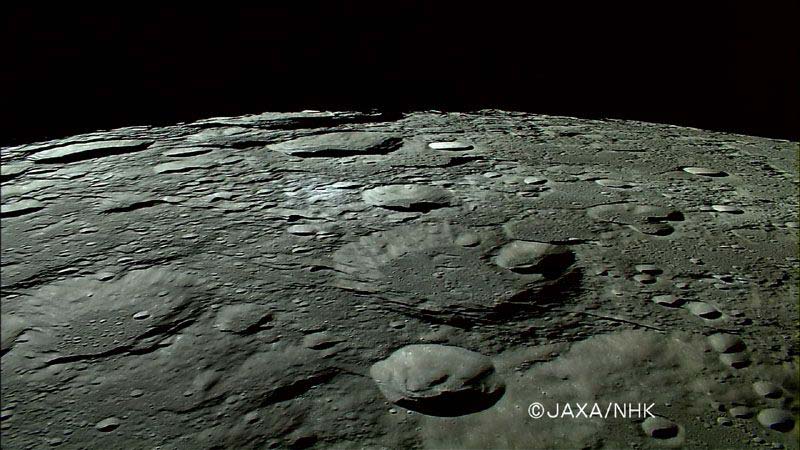What is the Moon Made Of?
The moon is the easiest body in the solar system to observe with the naked eye. People have wondered about the dark and light spots on the surface throughout history. What caused these strange features? People have also questioned what makes up our nearest neighbor.

The surface of the moon
Children's fairytales tell us that the moon is made of cheese, but like all bodies in the solar system, rock is the more realistic ingredient. The moon's surface is covered with dead volcanoes, impact craters, and lava flows, some visible to the unaided stargazer.
Early scientists thought the dark stretches of the moon might be oceans, and so named such features mare, which is Latin for "seas" (maria when there are more than one). They are oceans of a sort, but rather than water, such bodies are made up of pools of hardened lava. Early in the moon's history, the interior was molten enough to produce volcanoes, though it quickly cooled and hardened. Lava also burst from the crust when large enough asteroids broke through the surface.
The moon's surface shows plenty of evidence of asteroids, easily seen with a telescope during most moon phases. Early in the solar system's history, all of the planets and moons suffered through a period of heavy bombardment, as the last of the large rocks were captured by their gravity and crashed into their surface. On Earth, plate tectonics and erosion covered up much of the evidence from this period, while the atmosphere helped to burn up some of the smaller offenders before they hit the surface. But the moon lacks all three of these cleanup elements, so the history of the solar system is preserved on its surface.
Of course, the period of heavy bombardment, which ended about 3.8 billion years ago, wasn't responsible for all of the craters on the moon. Large and small asteroids continued to pelt the surface, but at a slower pace, leading to overlapping craters and craters on top of lava flows.
The crust of the moon is made up of a rocky surface covered with regolith. As asteroids and meteorites collide with the surface, they blast it into fine pieces that capture imprints (such as Neil Armstrong's famous footprint) in exceptional detail.
The crust of the moon is about 38 to 63 miles (60 to 100 kilometers) thick. The regolith on the surface can be as shallow as 10 feet (3 meters) in the maria or as deep as 66 feet (20 meters) in the highlands.
Under the surface
Like the Earth, the moon boasts a crust, mantle and core. Deep inside of its interior, the moon may have a solid iron core surrounded by a softer, somewhat molten liquid iron outer core. The outer core may extend as far out as 310 miles (500 km). But the small inner core only makes up about 20 percent of the moon, compared to the 50 percent core of other rocky bodies.
Most of the interior of the moon is made up of the lithosphere, which is about 620 miles (1,000 km) thick. As this region melted early in the lunar life, it supplied the magma necessary to create lava plains on the surface. However, over time, the magma cooled and solidified, thus ending volcanism on the moon.
Earth's moon is the second-densest moon in the solar system, beaten by Jupiter's moon, Io. The separation of its interior into layers was likely caused by the crystallization of a magma ocean shortly after its formation.
Related:
- Atmosphere of the Moon
- How Big is the Moon?
- How Far is the Moon?
- How Was the Moon Formed?
- What is the Temperature on the Moon?
- What is a Blue Moon?
- What is a Lunar Eclipse & When is the Next One?
- How Moon Phases Work
- Full Moon Calendar
Editor's Note: This story was updated to reflect a correction on Sept. 28 at 9:35 a.m. EDT. The original article incorrectly stated that the moon is the second-densest body in the solar system and that the moon is made up of a concrete-like regolith.
Follow Nola Taylor Redd at @NolaTRedd, Facebook, or Google+. Follow us at @Spacedotcom, Facebook or Google+.
Join our Space Forums to keep talking space on the latest missions, night sky and more! And if you have a news tip, correction or comment, let us know at: community@space.com.
Get the Space.com Newsletter
Breaking space news, the latest updates on rocket launches, skywatching events and more!

Nola Taylor Tillman is a contributing writer for Space.com. She loves all things space and astronomy-related, and enjoys the opportunity to learn more. She has a Bachelor’s degree in English and Astrophysics from Agnes Scott college and served as an intern at Sky & Telescope magazine. In her free time, she homeschools her four children. Follow her on Twitter at @NolaTRedd










